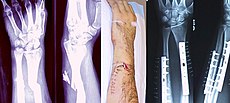Type a search term to find related articles by LIMS subject matter experts gathered from the most trusted and dynamic collaboration tools in the laboratory informatics industry.
| Bone fracture | |
|---|---|
| Classification and external resources | |
 Internal and external views of an arm with a compound fracture, both before and after surgery. | |
| ICD-10 | Sx2 (where x=0-9 depending on the location of the fracture) |
| ICD-9 | 829 |
| DiseasesDB | 4939 |
| MedlinePlus | 000001 |
| MeSH | D050723 |
Bone fractures happen when a bone is damaged by stress. The bone can be fractured in many different ways.
Most human bones are strong and do not break when hit by strong impacts or forces. However, if that force is too powerful, or there is something wrong with the bone, it can fracture.
There are many different types of bone fractures. Fractures are often separated into categories.
In an open fracture (also called a compound fracture), the broken bone breaks through the skin.[1] This can cause infection, since the skin usually protects the body from germs. If the skin is broken, germs can get into the body. Open fractures can also damage muscles, tendons and ligaments if the sharp ends of the broken bone go through them.[2]
In a closed fracture, the broken bone does not break through the skin.[1]
In a simple fracture, the broken bone is the only thing that is damaged.
In a complex fracture, the sharp ends of the broken bone damage the soft tissue around the bone.[1]
This is the type of injury in which the broken bone[3] has passed through the skin, forming some wounds. That is why it is also called an open fracture or composite fracture.[3] Compared to the simple fracture,[3] the open wound has made it even more dangerous since the person suffering from it is exposed to infection. Therefore, an operation may be necessary to prevent the wound from becoming infected.[3]
In a complete fracture, the bone is broken all the way through. The broken bone is in two separate pieces.[2]
In an incomplete fracture, the bone is not broken all the way through. The bone is partly broken, but it is still in one piece.[4] There are a few kinds of incomplete fractures, including:
In a comminuted fracture, at least three pieces of a bone have broken off. This means the bone is in four separate pieces or more (the main bone, plus the three or more pieces that have broken off).[5]
Sometimes people have multiple fractures. This can mean two different things:[4]
On average, it usually takes 6-8 weeks for a fracture to heal.[5] However, healing times depend on many different things, like which bones were broken, how bad the breaks were, age (younger people usually heal faster), and nutrition.[5]
Most fractures are diagnosed by using an X-ray. If the X-ray cannot see the fracture, other scans, like MRIs and CT scans, can show that a fracture exists.[5]
The best way to "fix" a bone fracture is to make sure the ends of the broken bone are lined up and tight together.[4] As the American Academy on Orthopedic Surgeons says:
"All forms of treatment of broken bones follow one basic rule: the broken pieces must be put back into position and prevented from moving out of place until they are healed.... Broken bone ends heal by "knitting" back together with new bone being formed around the edge of the broken parts."[2]
To help decrease pain from the fracture, doctors can prescribe medications or suggest over-the-counter painkillers.[6]
Scientists have come up with a few ways to "regenerate bone" (make the bone grow again). Their many ideas for future strategies include doing gene therapy and using 3-D printers.[7]
{{cite web}}: More than one of |archivedate= and |archive-date= specified (help); More than one of |archiveurl= and |archive-url= specified (help)
{{cite web}}: Missing or empty |url= (help)
{{cite journal}}: CS1 maint: multiple names: authors list (link) CS1 maint: numeric names: authors list (link)